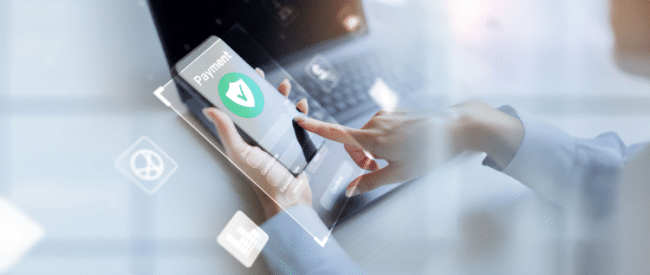You might be skeptical that an omnichannel communication platform is that significant when it comes to building customer loyalty. What about the sales or loan experience? What about the quality of the product or service itself, from reliable energy to medical care to vacation resorts?
There’s no denying the importance of the interaction or transaction itself. But every contact on the customer journey makes a positive or negative impression.
These cumulative experiences have an outsized impact on loyalty: A Gartner survey of more than 4,000 B2C and B2B customers found that CX drives 66% of customer loyalty. The balance is divided between brand perception and price, particularly in relation to the usefulness of customers’ experiences using or owning a product or service.
Billing and payments experiences in particular are often decisive in creating lasting customer opinions. These are usually the final acts, and thus loom large, in any customer engagement. That’s especially true if the financial relationship lasts far longer than the transaction itself—securing a 7-year auto loan or 30-year mortgage versus paying them off.
An omnichannel communications platform can turn these pivotal touchpoints into a strategic opportunity for delivering better CX that, first and foremost, helps drive on-time payments. With many U.S. households struggling to make ends meet, billing statements and other communications experiences (such as timely payment reminders) that cater to each consumer’s preferences can prompt payment over other bills.
Beyond succeeding at the main purpose of the bill, which is to instigate payment, companies can leverage omnichannel customer communications over time to develop stronger customer relationships and, ultimately, loyalty.
Omnichannel communication platforms in action
Make no mistake: Consumer expectations for their business interactions are high and getting higher as leading brands such as Apple and Amazon continually raise the bar. Because many companies fall short in delivering what consumers want, an omnichannel communication platform can give leaders a competitive edge. In fact, 4 out of 5 customers would switch to a competitor if they found the other company/brand provided a better CX, according to The State of Customer Service and CX 2024.
In billing and other customer communications, as well as payments, the baseline expectations are choice, convenience, ease of use and personalization:
Meet delivery channel preferences
Convenience and ease of use are directly related to fulfilling the choice of how customers want to communicate with businesses, from mail to mobile. Demand for digital billing and other communications has been growing for years but mailed paper statements remain a favorite for many. In the first half of 2024, 60% of consumers preferred electronic statements, 16% wanted paper and 25% wanted both, according to ACI Speedpay Pulse.
While these are consumers’ preferences, they aren’t always met because many billers do not offer electronic communications options such as email and text messaging. An omnichannel communications platform is key to changing that, enabling billers to leverage one process/solution to provide paper and digital billing statements and other communications.
Cloud omnichannel communication software gives billers the control and agility to create, modify, update, track and report on all their mail, email and text communications. To seamlessly complete the process from development to distribution, some platforms are integrated with digital and print and mail outsourcing. To improve the consumer experience and operating efficiency throughout the billing and payments lifecycle, companies also can choose omnichannel platforms that integrate with electronic bill presentment and payment (EBPP) systems.
Consolidate to simplify
The complexity of managing diverse combinations of customer communications can be daunting, causing some companies to delay adding and customizing delivery options. A single omnichannel communication platform is the solution to simplifying the complexity and delivering better CX.
Consolidating communications streamlines operations versus managing different systems and vendors for each channel. With robust omnichannel communication platforms, also known as customer communications (CCM) management software, companies can draw from their custom content libraries and document templates to quickly develop communications for different channels. Centralizing omnichannel customer communications also facilitates brand consistency and unified voice across channels.
Personalize content
Providing communications via their channel of choice is the first layer of personalization that customers are looking for. But customers also want personalized billing statements and messaging so they feel the company understands and is acting on their specific needs and wants.
An omnichannel communication platform makes this level of customization fast and easy. Companies pull from their content library and document templates with fields for custom information and other content, then upload a single data file so the platform merges the elements to customize each letter, statement, email, welcome kit or marketing piece.
Go beyond baseline to promote loyalty
Meeting baseline customer expectations for billing experiences leads to customer satisfaction and it separates communication leaders from other companies. But satisfying experiences may not translate into customer loyalty that manifests as repeat business, choosing the company over competitors and/or promoting the company to others.
Nearly 1 in 4 customers will take their business elsewhere if companies just “satisfy” them. That’s even more true of younger generations: 19% of Boomer customers are not likely to come back after a satisfactory experience but it’s 29% for Gen Z, according to The State of Customer Service and CX 2024.
Moving customers from satisfaction to loyalty requires what Gartner calls value enhancement. An omnichannel communication platform is key to supplementing transactional billing experiences with relationship-building content and communications.
Companies can add value and take billing CX to a new level by:
- Educating customers. Provide helpful information and tips in the communications themselves as well as links/website addresses for how-to videos, tutorials and other resources so customers can make the most of products/services, reinforcing their good feelings about the purchase.
- Anticipating customer needs. Make refinancing offers as rates come down or introduce new features and new products/services they might want.
- Humanizing the company. Emotional connections to a brand help build loyalty. Companies can showcase their values in action, such as supplying updates on sustainability, charitable giving and volunteer efforts.
While some of these value enhancements can be delivered to all customers, the effectiveness of other value-add communications depends on customizing them. An omnichannel communication platform enables both types, making it simple to tailor value enhancements in bills and other communications for different customer segments.
With omnichannel communications platforms, organizations can realize a multitude of benefits, including increased cash flow and revenues. These versatile and powerful technology solutions allow companies to deliver the kinds of customer experiences through billing and other omnichannel communications that increase satisfaction, lower barriers to payment, and forge customer relationships that strengthen into loyalty and preference.
Want to improve your customer experience with omnichannel communications? Request a demo to see our platform in action.







